Many dogs, both large and small, will shed their coats during temperature changes, times of stress, or during illnesses. Shedding is normally a very natural thing for dogs. Some dogs will shed their overcoats, while others will only shed their undercoats.
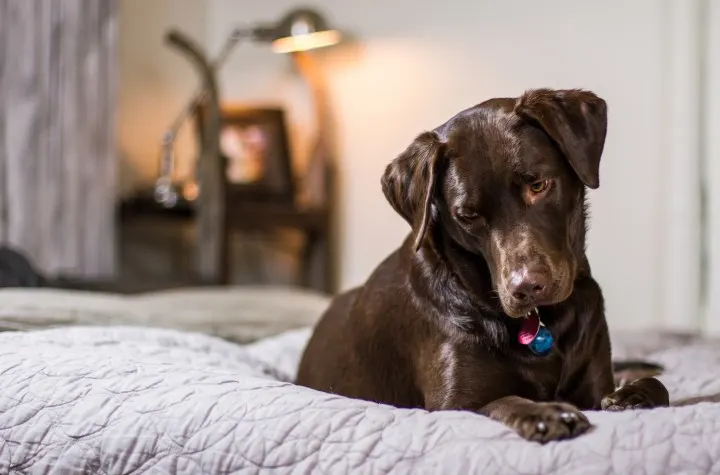 Like most other dog breeds, Chocolate Labs do shed. However, they usually only shed their undercoat during major seasonal changes.
Like most other dog breeds, Chocolate Labs do shed. However, they usually only shed their undercoat during major seasonal changes.
If properly managed with regular grooming, either at home or by a professional, shedding will not become a major problem in your home.
While Chocolate Labs make amazing family dogs and companions, their shedding may be more than some people want to handle or are able to tolerate. Keep reading, however, as there are many practical ways you can properly manage the amount of shedding your Lab does.
Do Chocolate Labs Shed Year-Round?
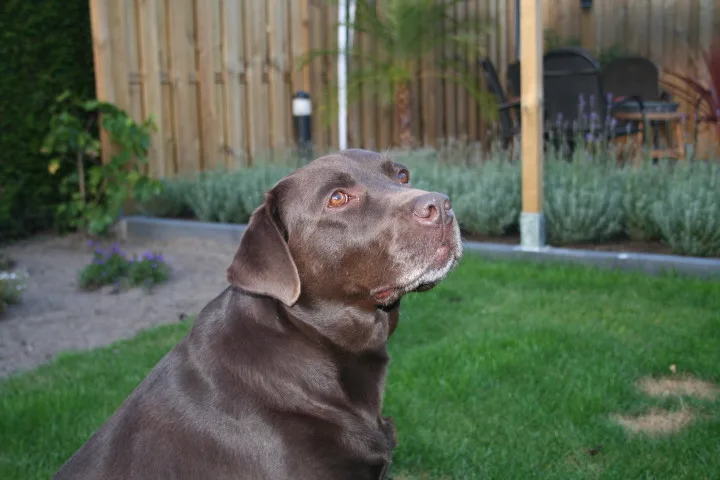 Chocolate Labs normally shed their coats twice a year. Once when going into summer or other warm seasonal temperatures, and a second time when going into winter.
Chocolate Labs normally shed their coats twice a year. Once when going into summer or other warm seasonal temperatures, and a second time when going into winter.
If you are in an area where there are no specific seasonal changes, your Chocolate Lab may shed small to moderate amounts of hair year-round, though this is not the norm for most areas.
For dogs that do not receive regular brushing, the coat may seem to shed year-round. This is because the shorter undercoat is being trapped by the longer guard hairs on top.
Brushing will help remove these hairs as well as make your dog much more comfortable and itch-free.
Use a metal comb, thick bristle brush, or an undercoat rake specifically made for double-coated breeds to help reduce the amount of hair that is trapped under the longer guard hairs of your dog.
This will not only make your Lab feel much better but will also help promote the production of natural skin oils. Such oils can aid in proper and regular shedding.
How Much Do Chocolate Labs Shed?
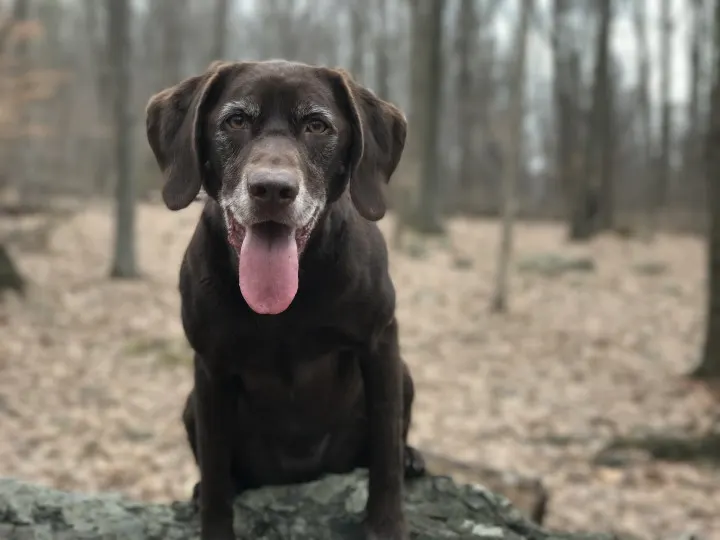 Labs of all colors have what is called a double coat. This double coat is made to repel water and keep the lab warm in cool temperatures.
Labs of all colors have what is called a double coat. This double coat is made to repel water and keep the lab warm in cool temperatures.
It consists of longer hairs on top called guard hairs, and shorter, more dense hairs close to the skin. Both types of hair will be shed, but you might notice more of the undercoat sticking to your furniture and clothing.
Labs are considered moderate to heavy shedders, so be prepared for dog hair on your furniture and in your carpeting. While they may not shed as much as long-coated breeds or other double-coated breeds such as a Siberian Husky, they will still lose their fair share of hair on a regular basis.
Do Chocolate Labs Shed More Than Other Labs?
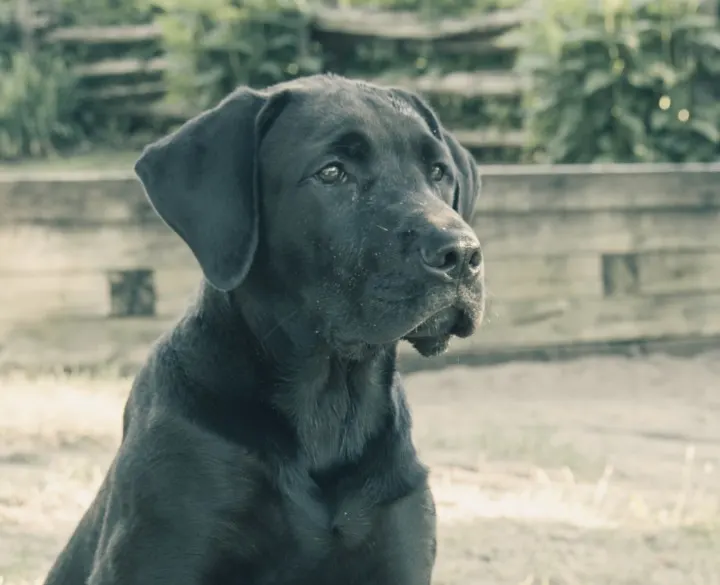 Since Chocolate, Black, and Yellow Labs are all the same breed and only different colors, there are no differences in the amount that one color will shed over another.
Since Chocolate, Black, and Yellow Labs are all the same breed and only different colors, there are no differences in the amount that one color will shed over another.
All Labs will shed their coat at different times of the year; usually in response to major seasonal or temperature changes.
In order to maintain a hair-free home, you will need to properly manage your Lab’s coat before shedding becomes an issue.
This may include professional grooming, bathing, coat raking, and more. Keep in mind that once you start a grooming schedule, it should be maintained as long as possible.
Skipping regular appointments may cause shedding to become worse over time.
Avoid Light Furniture
If your furniture is light-colored, and you have a Chocolate Lab, it may seem like there is no end to the amount of shedding your dog does. This is because the darker hairs on a Chocolate Lab are much easier to see on your lighter-colored furniture.
You will find the same is true for Yellow Labs in homes with darker-colored furniture. This does not mean your Lab is shedding more than other Labs or other breeds of dog, it simply means the hair is easier to see on your contrasting-colored furniture.
Some Lab owners suggest color-coordinating your decor to match your dog, so the hair is less visible to guests.
Is Shedding a Sign of Health Problems?
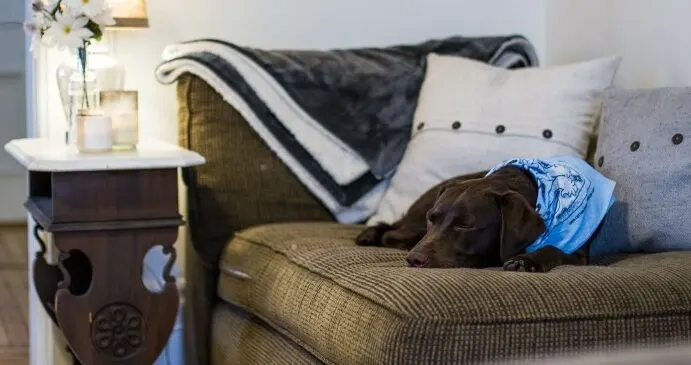 Shedding is a very normal process that most dogs go through on a seasonal basis. It is not uncommon to find some of your dogs’ shed hairs on your furniture or clothing all year round.
Shedding is a very normal process that most dogs go through on a seasonal basis. It is not uncommon to find some of your dogs’ shed hairs on your furniture or clothing all year round.
However, excessive shedding or hair that comes out in clumps and leaves thinned areas or bald spots can be a sign of a health problem.
Stress Can Cause Shedding
Stress can cause certain shedding-related issues. If your dog recently had to stay in a boarding kennel, go to the vet after a long time away, or move homes to an entirely strange destination, shedding between the normal seasonal pattern can happen.
Once the stress has been reduced and your dog is back to normal, he should return to his normal shedding pattern.
Possible Illnesses
Illnesses such as bacterial or fungal infections, skin allergies, and ringworm can also cause hair loss. This hair will normally be seen as extremely thin or completely missing in certain areas.
A veterinarian should be able to suggest topical creams or other treatment methods that can quickly clear up these issues and return your dog to its former glory.
How to Manage Labs Shedding
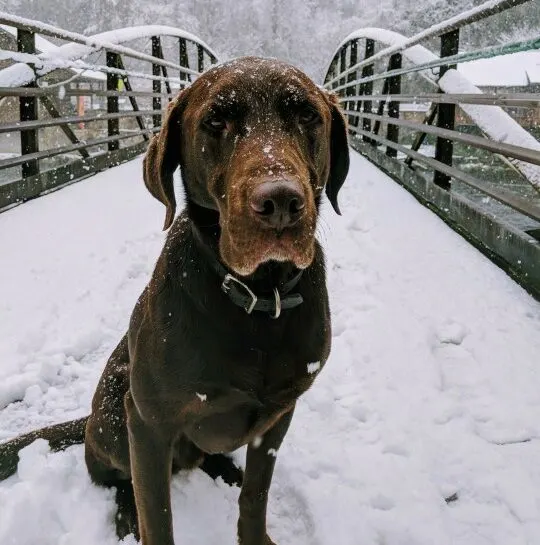 If you keep your Chocolate Lab indoors, you may be wondering how to limit the number of shed coats on your furniture and clothing.
If you keep your Chocolate Lab indoors, you may be wondering how to limit the number of shed coats on your furniture and clothing.
In order to prevent hair from being found all over your home, it is a good idea to regularly groom your Lab.
- Regular grooming and bathing. This not only helps remove the undercoat before it has a chance to get on your furniture and clothing but also helps boost the health of the Lab’s skin by producing natural oils. You should use shampoo that assists with proper shedding, rather than shampoo that is labeled as anti-shedding shampoo.
- Brush your lab regularly. It’s commonly suggested to brush your Chocolate Lab once a week with an undercoat rake or Furminator brush. This helps remove the loose or ready-to-shed coat before it has a chance to get onto furniture around your home.
- Remove hair with a vacuum. Once the hair has gotten onto your furniture, clothing, and into your carpeting, the best way to remove it is by using a vacuum cleaner specifically made for pet hair. You may also find something as simple as a lint roller or lint brush to be extremely effective at removing hair from the tops of furniture and your clothing.
Related Questions
Do Labs Normally Have Skin Problems?
Some individual Labs are more prone to skin problems than others. This can be due to genetics or how they are raised. Skin problems in Labs can directly lead to shedding problems or excessive shedding issues.
Skin problems that lead to hair loss or shedding issues in Labs are normally limited to Atopic Dermatitis. This is a very common inflammatory allergic reaction that affects up to 15% of Labs over the age of 3 years.
It can be caused by various environmental factors including pollen and dust that cause an over-reaction in their immune system.
The biggest sign of atopic dermatitis is a dog that seems to be itchy over its entire body. It may sometimes be localized to certain areas of the body and is most commonly seen along the spine and at the base of the tail.
Dogs may try to relieve their itch by scratching or gnawing at the area which can lead to extreme hair thinning or bald spots.
Can Food Help with Shedding?
While no food will be able to eliminate shedding entirely, high-quality meat-based foods can reduce the amount of hair that is shed in between grooming sessions.
Lower-quality foods use a large amount of grain-based fillers that can cause poor coat health. This can directly lead to excessive shedding or improper shedding schedules in your dog.
Even if fed a high-quality diet, you can add supplemental oils such as flaxseed oil and safflower oil. These natural oils provide ample amounts of fatty acids which help promote proper skin health, as well as hair follicle health in Labs of all ages.
Our Final Take
Whether you have a Chocolate Lab, or a Yellow or Black Lab, you should definitely be prepared for dog hair to become part of your household decor.
While Labs of all colors can be heavy shedders, there are easy regular ways you can control the amount that is left to accumulate around your home.
Chocolate Labs, and Labs of other colors, are great companions and can make an excellent family dog. Be sure to take their shedding into account before bringing a new Lab home, however.
Shedding is perfectly easy to manage with brushing and coat raking, so if you are not a fan of dog hair around your home, just be sure to keep your Lab on a regular grooming schedule with a professional groomer.
Our team is composed of pet care professionals, veterinarians, and pet owners. To date, we’ve conducted thousands of hours of research to publish the most accurate pet information.
Most of the writers on our site are vets with 10+ years of clinical experience, ranging from small practice, to equine practice, academia, and surgery. Our goal is to help every pet owner get the information they seek about their dear companions.



Leave a comment
You must be logged in to post a comment.